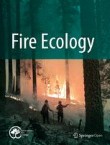Fire Ecology is the official journal of the Association for Fire Ecology.
Comparison of Burn Severities of Consecutive Large-Scale Fires in Florida Sand Pine Scrub Using Satellite Imagery Analysis
Remotely sensed imagery has been used extensively in the western US to evaluate patterns of burn severity and vegetation recovery following wildland fires. Its application in southern US ecosystems, however, h...
